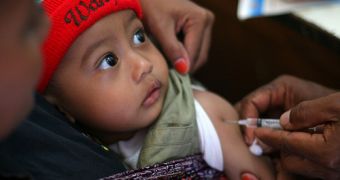Although everyone should benefit from influenza vaccine and the 'Vaccines for Children' program covers the actual cost of flu vaccine for Medicaid-eligible children, the vaccination rates for poor children are very low in the United States.
A new study carried out by a team of researchers at the University of Rochester Medical Center (URMC), concluded that increasing the amount that physicians are reimbursed by Medicaid for administrating influenza shots, could raise vaccination rates among poor kids.
The team looked at data from state-by-state vaccination over the last three flu seasons, and found that every additional dollar given to doctors to administer the vaccine would increase the number of poor children receiving the annual flu vaccine by up to one percent.
Their data was furnished by the National Immunization Survey (NIS) for the 2005-2006, 2006-2007, and 2007-2008 flu seasons, sponsored by the Centers for Disease Control and Prevention (CDC).
The researchers had access to a very detailed information, such as the family's income level, the number of children, the ethnicity and the mother's education level and marital status.
After analyzing all data available, the team realized that children in families below the federal poverty level – $22,000 or less for a family of four, had the lowest vaccination rates.
The next step was to compare the vaccination rates in each state with the amount of money reimbursed to physicians by Medicaid, for administrating the vaccine.
Even if the vaccine is fully reimbursed by Medicaid, the doctors still have extra costs for administrating it, like nurses and staff time, overhead, etc.
And as the Medicaid reimbursement rates are different from state to state, the team found that they could go from $2 in Colorado, Connecticut, and Hawaii to almost $18 in New York, with the average reimbursement rate being $9.
There is a huge difference between these figures and the actual cost to doctor's offices for administering vaccines, that Byung-Kwang Yoo, MD, PhD, assistant professor in the Department of Community and Preventive Medicine at URMC and the lead author of the study, found to be of $20.
“In most states the reimbursement from Medicaid is far below the actual cost,” Yoo said.
“That may create an obvious disincentive when physician's offices lose money every time they give a flu shot, even though vaccines are provided for free.”
To find a way of solving this problem, the authors used a mathematical model and found that for every extra dollar in reimbursement, vaccination rates could rise by between 0.6 and 0.9 percent, which could mean that a $10 increase could allow 10% of low income children to get vaccinated.
Obviously, it is not easy to find the extra money for this, but the authors point out that treating flu costs even more.
According to their calculations, the treatment for kids under the age of 5 costs up to $163 million per year, and the extra cost of emergency room visits rises up to $279 million.
URMC pediatrician Peter Szilagyi, M, M.P.H., co-author of the study said that “the more children with access to seasonal flu vaccinations, the lower the overall burden will be on our health care system from the costs associated with treating influenza.
“This study demonstrates that we can remove one of the barriers to higher vaccination rates among poor children by more closely aligning reimbursement with cost.”
The study was published online today in the journal Pediatrics.

 14 DAY TRIAL //
14 DAY TRIAL //